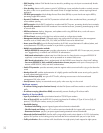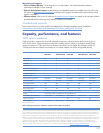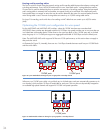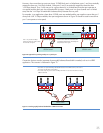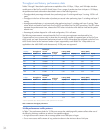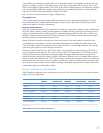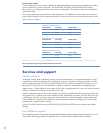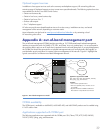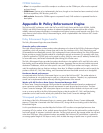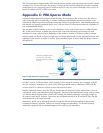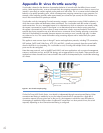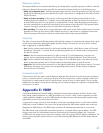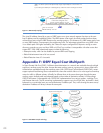
44
VRRP is an election protocol that dynamically assigns responsibility for a virtual router on a
LAN.
It provides high availability for a default gateway without the need to reconfigure end hosts
Router A
Multiple router interfaces comprise a
virtual router configured with a
common virtual IP address: 10.1.10.1
Intranet
and/or
Internet
Host: 10.1.10.10/24
Default Gateway: 10.1.10.1
Router B
Figure E-1: VRRP example topology
The virtual IP address shared by a group of VRRP routers on a given network segment functions as the next-
hop IP address used by neighboring hosts. The VRRP Master router simply forwards packets that have been
received from hosts using the VRRP Master as the next-hop gateway. The existence of a VRRP master and of one
or more VRRP Backups is transparent to the neighboring hosts. The advantage gained from using VRRP is that
it is a default path with higher availability, but it does not require configuration of dynamic routing or router
discovery protocols on every end host. VRRP on HP ProCurve switches is interoperable with other routers that
support RFC 3768. VRRP operational aspects include the following:
•Preemptive mode, which can be disabled to prevent VRRP router flapping
•Default Advertisement interval of one second
•Default Detection time of 3.6 seconds
Appendix F: OSPF Equal Cost Multipath
In Open Shortest Path First (OSPF), if different subnet destinations in a network are reachable through multiple
equal-cost, next-hop routes, the router chooses the same next-hop route at a given point in time to send traffic
to destinations reachable through that next-hop router. With OSPF Equal Cost Multipath (OSPF-ECMP), routers
support optional load-sharing across redundant links where the network offers two or more equal-cost next-hop
routes for traffic to different subnets. All traffic for different hosts in the same subnet goes through the same
next-hop router. Multiple paths are balanced based on the number of destination subnets. HP networking’s
OSPF-ECMP feature is interoperable with OSPF-ECMP implementations from various vendors, including Cisco
and Extreme Networks. The HP networking implementation supports up to four ECMP links, and traffic is load-
balanced on a round-robin basis per source/destination IP address pair. Thus, traffic sharing the same source/
destination IP address will always choose the same path.
Router B
Equal cost next-hop paths
Router A
Router 1 Router 2
Router 3
10.1.0.0/16
10.2.0.0/16
10.3.0.0/16
10.32.0.0/16
10.42.0.0/16
Router 4
Router C
Router D
Figure F-1: OSPF ECMP example technology



